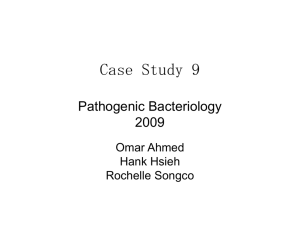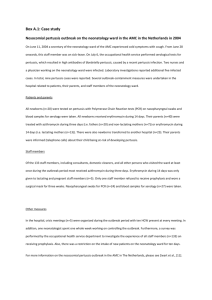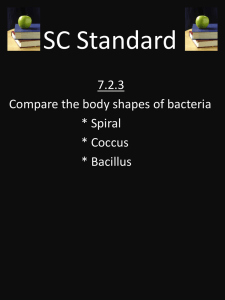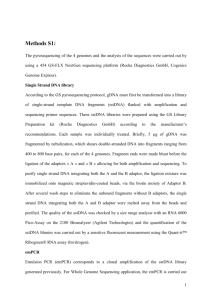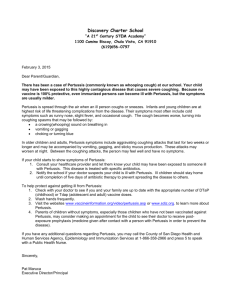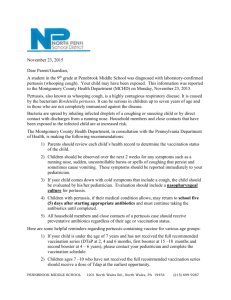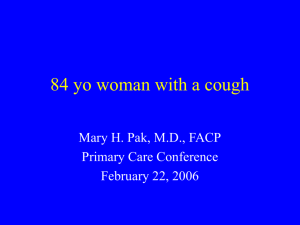B 6i8 November 2014
advertisement
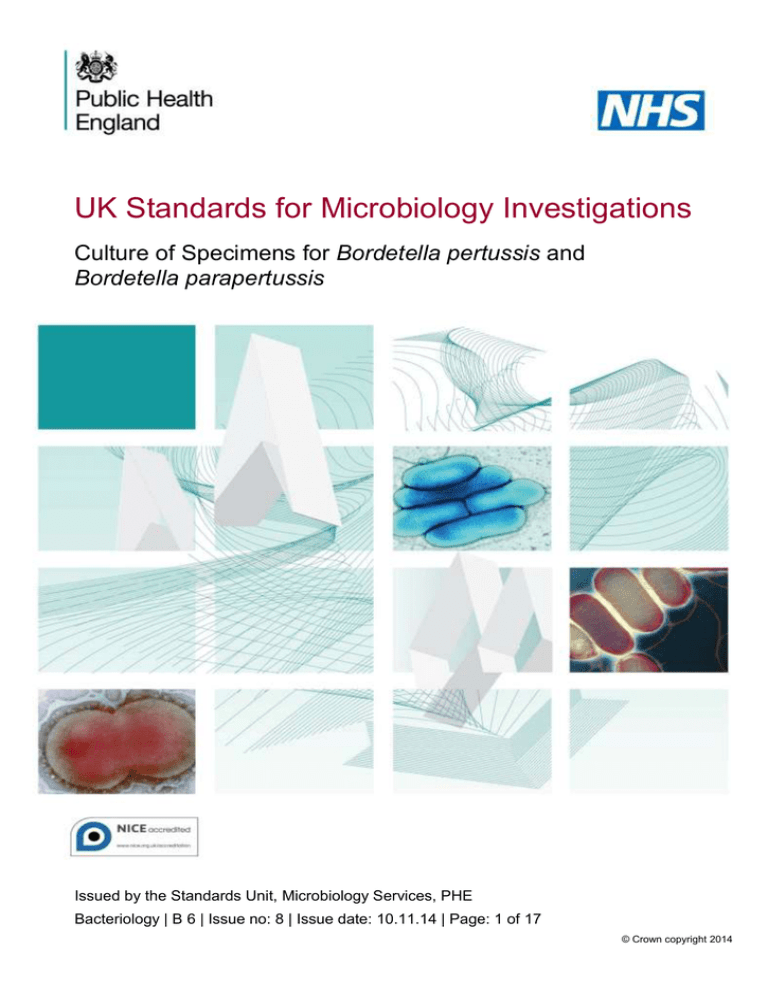
UK Standards for Microbiology Investigations Culture of Specimens for Bordetella pertussis and Bordetella parapertussis Issued by the Standards Unit, Microbiology Services, PHE Bacteriology | B 6 | Issue no: 8 | Issue date: 10.11.14 | Page: 1 of 17 © Crown copyright 2014 Culture of Specimens for Bordetella pertussis and Bordetella parapertussis Acknowledgments UK Standards for Microbiology Investigations (SMIs) are developed under the auspices of Public Health England (PHE) working in partnership with the National Health Service (NHS), Public Health Wales and with the professional organisations whose logos are displayed below and listed on the website https://www.gov.uk/ukstandards-for-microbiology-investigations-smi-quality-and-consistency-in-clinicallaboratories. SMIs are developed, reviewed and revised by various working groups which are overseen by a steering committee (see https://www.gov.uk/government/groups/standards-for-microbiology-investigationssteering-committee). The contributions of many individuals in clinical, specialist and reference laboratories who have provided information and comments during the development of this document are acknowledged. We are grateful to the Medical Editors for editing the medical content. For further information please contact us at: Standards Unit Microbiology Services Public Health England 61 Colindale Avenue London NW9 5EQ E-mail: standards@phe.gov.uk Website: https://www.gov.uk/uk-standards-for-microbiology-investigations-smi-qualityand-consistency-in-clinical-laboratories UK Standards for Microbiology Investigations are produced in association with: Logos correct at time of publishing. Bacteriology | B 6 | Issue no: 8 | Issue date: 10.11.14 | Page: 2 of 17 UK Standards for Microbiology Investigations | Issued by the Standards Unit, Public Health England Culture of Specimens for Bordetella pertussis and Bordetella parapertussis Contents ACKNOWLEDGMENTS .......................................................................................................... 2 AMENDMENT TABLE ............................................................................................................. 4 UK SMI: SCOPE AND PURPOSE ........................................................................................... 5 SCOPE OF DOCUMENT ......................................................................................................... 7 SCOPE .................................................................................................................................... 7 INTRODUCTION ..................................................................................................................... 7 TECHNICAL INFORMATION/LIMITATIONS ........................................................................... 8 1 SAFETY CONSIDERATIONS .................................................................................... 10 2 SPECIMEN COLLECTION ......................................................................................... 10 3 SPECIMEN TRANSPORT AND STORAGE ............................................................... 11 4 SPECIMEN PROCESSING/PROCEDURE ................................................................. 11 5 REPORTING PROCEDURE ....................................................................................... 13 6 NOTIFICATION TO PHE OR EQUIVALENT IN THE DEVOLVED ADMINISTRATIONS .................................................................................................. 13 APPENDIX: CULTURE OF SPECIMENS FOR BORDETELLA PERTUSSIS AND BORDETELLA PARAPERTUSSIS ............................................................................ 14 REFERENCES ...................................................................................................................... 15 Bacteriology | B 6 | Issue no: 8 | Issue date: 10.11.14 | Page: 3 of 17 UK Standards for Microbiology Investigations | Issued by the Standards Unit, Public Health England Culture of Specimens for Bordetella pertussis and Bordetella parapertussis Amendment Table Each SMI method has an individual record of amendments. The current amendments are listed on this page. The amendment history is available from standards@phe.gov.uk. New or revised documents should be controlled within the laboratory in accordance with the local quality management system. Amendment No/Date. 11/10.11.14 Issue no. discarded. 7.2 Insert Issue no. 8 Section(s) involved Amendment Whole document. Hyperlinks updated to gov.uk. Page 2. Updated logos added. Whole document. The title changed from investigation to culture of specimens and therefore reference to serological investigation removed or minimised. The focus of the SMI is culture for Pertussis. Type of Specimen. Updated. Scope. Updated. Introduction. Updated to include PCR and MALDI-TOF and brought in line with the PHE Guidelines for Public Health Management of Pertussis 2012. Technical Information/Limitations. Updated and additional information added. References. Some references updated. Bacteriology | B 6 | Issue no: 8 | Issue date: 10.11.14 | Page: 4 of 17 UK Standards for Microbiology Investigations | Issued by the Standards Unit, Public Health England Culture of Specimens for Bordetella pertussis and Bordetella parapertussis UK SMI: Scope and Purpose Users of SMIs Primarily, SMIs are intended as a general resource for practising professionals operating in the field of laboratory medicine and infection specialties in the UK. SMIs also provide clinicians with information about the available test repertoire and the standard of laboratory services they should expect for the investigation of infection in their patients, as well as providing information that aids the electronic ordering of appropriate tests. The documents also provide commissioners of healthcare services with the appropriateness and standard of microbiology investigations they should be seeking as part of the clinical and public health care package for their population. Background to SMIs SMIs comprise a collection of recommended algorithms and procedures covering all stages of the investigative process in microbiology from the pre-analytical (clinical syndrome) stage to the analytical (laboratory testing) and post analytical (result interpretation and reporting) stages. Syndromic algorithms are supported by more detailed documents containing advice on the investigation of specific diseases and infections. Guidance notes cover the clinical background, differential diagnosis, and appropriate investigation of particular clinical conditions. Quality guidance notes describe laboratory processes which underpin quality, for example assay validation. Standardisation of the diagnostic process through the application of SMIs helps to assure the equivalence of investigation strategies in different laboratories across the UK and is essential for public health surveillance, research and development activities. Equal Partnership Working SMIs are developed in equal partnership with PHE, NHS, Royal College of Pathologists and professional societies. The list of participating societies may be found at https://www.gov.uk/uk-standards-for-microbiology-investigations-smi-qualityand-consistency-in-clinical-laboratories. Inclusion of a logo in an SMI indicates participation of the society in equal partnership and support for the objectives and process of preparing SMIs. Nominees of professional societies are members of the Steering Committee and Working Groups which develop SMIs. The views of nominees cannot be rigorously representative of the members of their nominating organisations nor the corporate views of their organisations. Nominees act as a conduit for two way reporting and dialogue. Representative views are sought through the consultation process. SMIs are developed, reviewed and updated through a wide consultation process. Quality Assurance NICE has accredited the process used by the SMI Working Groups to produce SMIs. The accreditation is applicable to all guidance produced since October 2009. The process for the development of SMIs is certified to ISO 9001:2008. SMIs represent a good standard of practice to which all clinical and public health microbiology Microbiology is used as a generic term to include the two GMC-recognised specialties of Medical Microbiology (which includes Bacteriology, Mycology and Parasitology) and Medical Virology. Bacteriology | B 6 | Issue no: 8 | Issue date: 10.11.14 | Page: 5 of 17 UK Standards for Microbiology Investigations | Issued by the Standards Unit, Public Health England Culture of Specimens for Bordetella pertussis and Bordetella parapertussis laboratories in the UK are expected to work. SMIs are NICE accredited and represent neither minimum standards of practice nor the highest level of complex laboratory investigation possible. In using SMIs, laboratories should take account of local requirements and undertake additional investigations where appropriate. SMIs help laboratories to meet accreditation requirements by promoting high quality practices which are auditable. SMIs also provide a reference point for method development. The performance of SMIs depends on competent staff and appropriate quality reagents and equipment. Laboratories should ensure that all commercial and in-house tests have been validated and shown to be fit for purpose. Laboratories should participate in external quality assessment schemes and undertake relevant internal quality control procedures. Patient and Public Involvement The SMI Working Groups are committed to patient and public involvement in the development of SMIs. By involving the public, health professionals, scientists and voluntary organisations the resulting SMI will be robust and meet the needs of the user. An opportunity is given to members of the public to contribute to consultations through our open access website. Information Governance and Equality PHE is a Caldicott compliant organisation. It seeks to take every possible precaution to prevent unauthorised disclosure of patient details and to ensure that patient-related records are kept under secure conditions. The development of SMIs are subject to PHE Equality objectives https://www.gov.uk/government/organisations/public-healthengland/about/equality-and-diversity. The SMI Working Groups are committed to achieving the equality objectives by effective consultation with members of the public, partners, stakeholders and specialist interest groups. Legal Statement Whilst every care has been taken in the preparation of SMIs, PHE and any supporting organisation, shall, to the greatest extent possible under any applicable law, exclude liability for all losses, costs, claims, damages or expenses arising out of or connected with the use of an SMI or any information contained therein. If alterations are made to an SMI, it must be made clear where and by whom such changes have been made. The evidence base and microbial taxonomy for the SMI is as complete as possible at the time of issue. Any omissions and new material will be considered at the next review. These standards can only be superseded by revisions of the standard, legislative action, or by NICE accredited guidance. SMIs are Crown copyright which should be acknowledged where appropriate. Suggested Citation for this Document Public Health England. (2014). Culture of Specimens for Bordetella pertussis and Bordetella parapertussis. UK Standards for Microbiology Investigations. B 6 Issue 8. https://www.gov.uk/uk-standards-for-microbiology-investigations-smi-quality-andconsistency-in-clinical-laboratories Bacteriology | B 6 | Issue no: 8 | Issue date: 10.11.14 | Page: 6 of 17 UK Standards for Microbiology Investigations | Issued by the Standards Unit, Public Health England Culture of Specimens for Bordetella pertussis and Bordetella parapertussis Scope of Document Type of Specimen Pernasal swab, nasopharyngeal aspirate, nasopharyngeal swab Scope The SMI describes the culture and bacteriological investigation of pernasal swabs, nasopharyngeal aspirates and nasopharyngeal swabs for Bordetella pertussis and Bordetella parapertussis. Information about serological confirmation of pertussis is available from the PHE website. This SMI should be used in conjunction with other SMIs. Introduction Pertussis, commonly known as whooping cough (“violent cough”) has been associated with high morbidity and mortality, particularly in infants. Whooping cough is a highly contagious disease that is caused by the fastidious Gram negative coccobacillus B. pertussis and B. parapertussis that colonises the respiratory tract1. The main symptoms include malaise, fever followed by long bursts of coughing and choking leaving the infected person gasping for breath with a characteristic whoop sound. B. pertussis usually infects and causes severe respiratory disease in young children with infants under six months of age at most risk of severe complications. The infection can occur in adolescents and adults who exhibit milder symptoms of flu like illness followed by a prolonged cough2,3. The incubation period of pertussis is on average between 7–10 days (range 5–21days). Despite a sustained period of high vaccine coverage, pertussis continues to display cyclical peaks in activity occurring every three to four years. An increase in pertussis activity in England and Wales was observed from the third quarter of 2011, predominantly in adolescents and adults. This increase continued into 2012 and extended into infants under three months who are at highest risk of severe complications, hospitalisation and death (https://www.gov.uk/government/collections/pertussis-guidance-data-and-analysis). Diagnosis of pertussis is usually straight forward however, formesfrustes (abortive or atypical disease; disease stopped before it has run its full course) are known to occur, and may cause diagnostic difficulty. Consideration should be given to appropriate evaluation of patients with pertussis in whom infection with B. pertussis or B. parapertussis cannot be demonstrated. In addition to sampling for pertussis, it is recommended that consideration is given to testing the patient for respiratory viruses according to local procedures. Laboratory confirmation of clinically suspected cases can be made by culture and isolation of the causative organisms B. pertussis and B. parapertussis, detection of its DNA (typically from nasopharyngeal swabs/pernasal swabs or nasopharyngeal aspirates) or serological tests (which usually only provide a late or retrospective diagnosis). Culture has sensitivity as low as 20-40% and can be affected by a number of factors as the organism is delicate including delays in processing and specimen quality4. Bacteriology | B 6 | Issue no: 8 | Issue date: 10.11.14 | Page: 7 of 17 UK Standards for Microbiology Investigations | Issued by the Standards Unit, Public Health England Culture of Specimens for Bordetella pertussis and Bordetella parapertussis Culture is the gold standard for diagnosis of infection with B. pertussis and B. parapertussis. The method is highly specific but the sensitivity is low, declining with the duration of illness and with the age of the patients. However, polymerase chain reaction (PCR) is a specific, sensitive and rapid method for the diagnosis of pertussis in respiratory samples5. Developments in PCR have enabled the detection and differentiation of B. pertussis from other species of Bordetella. However, several amplification targets used for Bordetella are present in more than one Bordetella species and therefore PCR results should be interpreted with caution eg IS 481 is present in B. pertussis, B. holmesii and B. bronchiseptica6. qPCR is invaluable in pertussis confirmation in young infants and has shown to have improved sensitivity over culture7. qPCR is also valuable for epidemiological analysis however, culture techniques still remain necessary for antibiotic susceptibility8,9. Matrix-assisted laser desorption-ionization time-of-flight mass spectrometry (MALDITOF MS) has been shown to be a rapid and powerful identification tool because of its reproducibility, speed and sensitivity of analysis. The advantage of MALDI-TOF as compared with other identification methods is that the results of the analysis are available within a few hours rather than several days10. However, there is currently very little scientific information published on use of MALDI-TOF MS for detection of Bordetella species11. Early laboratory diagnosis is important for control and prevention of whooping cough. Isolation and typing of the organism is also important for the continued monitoring of the vaccine programme. Vaccination provides the most effective strategy for preventing pertussis transmission in the population, although protection afforded by vaccination or from past infection is not lifelong12. In response to a significant increase in laboratory confirmed cases of pertussis and the high rates of disease in young infants, the Health Protection Agency (Public Health England since April 2013) declared a level 3 incident (national outbreak) in April 201213. On 28th September 2012, the Department of Health announced the introduction of a temporary programme to vaccinate pregnant women against pertussis14. This temporary programme, which is an outbreak control measure, aims to passively protect infants from birth before they reach the age of routine immunisation and during the period of greatest risk of complications and death12. Technical Information/Limitations Specimen Containers15,16 SMIs use the term “CE marked leak proof container” to describe containers bearing the CE marking used for the collection and transport of clinical specimens. The requirements for specimen containers are given in the EU in vitro Diagnostic Medical Devices Directive (98/79/EC Annex 1 B 2.1) which states: “The design must allow easy handling and, where necessary, reduce as far as possible contamination of, and leakage from, the device during use and, in the case of specimen receptacles, the risk of contamination of the specimen. The manufacturing processes must be appropriate for these purposes”. Bacteriology | B 6 | Issue no: 8 | Issue date: 10.11.14 | Page: 8 of 17 UK Standards for Microbiology Investigations | Issued by the Standards Unit, Public Health England Culture of Specimens for Bordetella pertussis and Bordetella parapertussis Selective Media17-19 The nature of selective media requires a balance between the performance characteristics and the costs of the tests. Selective media may not support the growth of all circulating strains of organisms. Refer to manufacturer’s instructions and recent evidence for limitations of growth. The media should support the growth of B. pertussis and B. parapertussis, suppress nasopharyngeal flora and be stable during storage. There are several different types of medium available that contain blood or charcoal or both, along with selective antibiotic supplements - penicillin, cefalexin or meticillin. Meticillin is the least inhibitory of these towards B. pertussis, but is also the least inhibitory towards nasopharyngeal flora. Cefalexin is the most inhibitory towards nasopharyngeal flora and is superior to penicillin. For these reasons it is the antibiotic of choice for selective media in this SMI19. Primary isolation plates are incubated at 35-37°C, in an aerobic moist atmosphere maintained for 7 days18. A thickly poured plate is necessary to avoid desiccation on prolonged incubation. Specimen Type Current recommendation for specimen of choice is nasopharyngeal aspirates or nasopharyngeal swabs/pernasal swabs12. In addition to sampling for pertussis, it is recommended that consideration is given to testing the patient for respiratory viruses according to local procedures. Cough plates are not recommended. Pernasal Swabs Dacron and rayon swabs are the swabs of choice for both PCR and culture. Both types of synthetic material performed well in studies with neither superior to the other20. Bacteriology | B 6 | Issue no: 8 | Issue date: 10.11.14 | Page: 9 of 17 UK Standards for Microbiology Investigations | Issued by the Standards Unit, Public Health England Culture of Specimens for Bordetella pertussis and Bordetella parapertussis 1 Safety Considerations15,16,21-35 1.1 Specimen Collection, Transport and Storage15,16,21-24 Use aseptic technique. Collect specimens in appropriate transport medium in CE marked leak proof containers and transport in sealed plastic bags. Compliance with postal, transport and storage regulations is essential. 1.2 Specimen Processing15,16,21-35 Containment Level 2. Laboratory procedures that give rise to infectious aerosols must be conducted in a microbiological safety cabinet27. Refer to current guidance on the safe handling of all organisms documented in this SMI. The above guidance should be supplemented with local COSHH and risk assessments. 2 Specimen Collection 2.1 Type of Specimens Pernasal swab, nasopharyngeal aspirate, nasopharyngeal swab 2.2 Optimal Time and Method of Collection36 For safety considerations refer to Section 1.1. Collect specimens before antimicrobial therapy where possible36. Swabs should be collected and transported in charcoal-based transport medium such as Regan-Lowe. Pernasal swabs A pernasal swab (Dacron or rayon with flexible ultrafine wire shaft) is inserted through a nostril and advanced along the floor of the nose until it reaches the nasopharynx. It has been suggested that the swab is held against the posterior nasopharynx for up to 30s or until the patient coughs. In practice, it is more likely that a patient will only be able to tolerate this for a few seconds. Nasopharyngeal specimens Sampling of nasopharyngeal secretions in patients with whooping cough may precipitate a paroxysm of coughing and cause obstruction of the airways. Resuscitation equipment must be available if whooping cough is suspected. The specimen collector should avoid exposure to direct coughs from the patient. Nasopharyngeal exudate may be obtained using a suction catheter (No.8 French) inserted through the nose. The exudate is collected in a sterile plastic trap in which the specimen is transported to the laboratory, or in a sterile clear plastic universal container (30mL or 60mL, to BS 5213). Note: Cough plates are not recommended. Bacteriology | B 6 | Issue no: 8 | Issue date: 10.11.14 | Page: 10 of 17 UK Standards for Microbiology Investigations | Issued by the Standards Unit, Public Health England Culture of Specimens for Bordetella pertussis and Bordetella parapertussis Collect specimens other than swabs into appropriate CE marked leak proof containers and place in sealed plastic bags. Unless otherwise stated, swabs for bacterial and fungal culture should then be placed in appropriate transport medium37-41. 2.3 Adequate Quantity and Appropriate Number of Specimens36 Numbers and frequency of specimen collection are dependent on clinical condition of patient. 3 Specimen Transport and Storage15,16 3.1 Optimal Transport and Storage Conditions For safety considerations refer to Section 1.1. Specimens should be transported and processed as soon as possible 36. If processing is delayed, refrigeration is preferable to storage at ambient temperature36. 4 Specimen Processing/Procedure15,16 4.1 Test Selection N/A 4.2 Appearance N/A 4.3 Sample Preparation For safety considerations refer to Section 1.2. 4.4 Microscopy N/A 4.5 Culture and Investigation Pernasal and nasopharyngeal swabs Inoculate each agar plate with swab (refer to Q 5 - Inoculation of Culture Media for Bacteriology). For the isolation of individual colonies, spread inoculum with a sterile loop. Nasopharyngeal aspirate With a sterile loop select a representative portion of specimen and inoculate a loopful to each agar plate (refer to Q 5 - Inoculation of Culture Media for Bacteriology). For the isolation of individual colonies, spread inoculum with a sterile loop. Bacteriology | B 6 | Issue no: 8 | Issue date: 10.11.14 | Page: 11 of 17 UK Standards for Microbiology Investigations | Issued by the Standards Unit, Public Health England Culture of Specimens for Bordetella pertussis and Bordetella parapertussis 4.5.1 Culture media, conditions and organisms Clinical details/ Specimen Standard media conditions Pertussis or whooping cough 4.6 Pernasal swab, nasopharyngeal aspirate, nasopharyngeal swab Charcoal blood agar with cefalexin Incubation Temp °C Atmos Time 35-37 air, 7d moist chamber Cultures read Target organism(s) 4d and 7d B. pertussis B. parapertussis Identification Refer to individual SMIs for organism identification. 4.6.1 Minimum level of identification in the laboratory Bordetella species 4.7 "Species" level Antimicrobial Susceptibility Testing N/A 4.8 Referral for Outbreak Investigations N/A 4.9 Referral to Reference Laboratories For information on the tests offered, turn around times, transport procedure and the other requirements of the reference laboratory click here for user manuals and request forms. For the investigation of suspected clusters or outbreaks of pertussis, please contact the Respiratory and Vaccine Preventable Bacteria Reference Unit, Colindale for the most appropriate test. Information regarding specialist and reference laboratories is available via the following website: PHE - Specialist and Reference Microbiology Tests and Services. Organisms with unusual or unexpected resistance, and whenever there is a laboratory or clinical problem, or anomaly that requires elucidation should be sent to the appropriate reference laboratory. Contact appropriate devolved national reference laboratory for information on the tests available, turn around times, transport procedure and any other requirements for sample submission: England and Wales https://www.gov.uk/specialist-and-reference-microbiology-laboratory-tests-andservices Scotland http://www.hps.scot.nhs.uk/reflab/index.aspx Northern Ireland Bacteriology | B 6 | Issue no: 8 | Issue date: 10.11.14 | Page: 12 of 17 UK Standards for Microbiology Investigations | Issued by the Standards Unit, Public Health England Culture of Specimens for Bordetella pertussis and Bordetella parapertussis http://www.publichealth.hscni.net/directorate-public-health/health-protection 5 Reporting Procedure 5.1 Microscopy N/A 5.2 Culture Negatives "Bordetella pertussis NOT isolated". Positives "Bordetella pertussis isolated" or "Bordetella parapertussis isolated". 5.3 Antimicrobial Susceptibility Testing Report susceptibilities as clinically indicated. Prudent use of antimicrobials according to local and national protocols is recommended. 6 Notification to PHE42,43 or Equivalent in the Devolved Administrations44-47 The Health Protection (Notification) regulations 2010 require diagnostic laboratories to notify Public Health England (PHE) when they identify the causative agents that are listed in Schedule 2 of the Regulations. Notifications must be provided in writing, on paper or electronically, within seven days. Urgent cases should be notified orally and as soon as possible, recommended within 24 hours. These should be followed up by written notification within seven days. For the purposes of the Notification Regulations, the recipient of laboratory notifications is the local PHE Health Protection Team. If a case has already been notified by a registered medical practitioner, the diagnostic laboratory is still required to notify the case if they identify any evidence of an infection caused by a notifiable causative agent. Notification under the Health Protection (Notification) Regulations 2010 does not replace voluntary reporting to PHE. The vast majority of NHS laboratories voluntarily report a wide range of laboratory diagnoses of causative agents to PHE and many PHE Health protection Teams have agreements with local laboratories for urgent reporting of some infections. This should continue. Note: The Health Protection Legislation Guidance (2010) includes reporting of Human Immunodeficiency Virus (HIV) & Sexually Transmitted Infections (STIs), Healthcare Associated Infections (HCAIs) and Creutzfeldt–Jakob disease (CJD) under ‘Notification Duties of Registered Medical Practitioners’: it is not noted under ‘Notification Duties of Diagnostic Laboratories’. https://www.gov.uk/government/organisations/public-health-england/about/ourgovernance#health-protection-regulations-2010 Other arrangements exist in Scotland44,45, Wales46 and Northern Ireland47. Bacteriology | B 6 | Issue no: 8 | Issue date: 10.11.14 | Page: 13 of 17 UK Standards for Microbiology Investigations | Issued by the Standards Unit, Public Health England Culture of Specimens for Bordetella pertussis and Bordetella parapertussis Appendix: Culture of Specimens for Bordetella pertussis and Bordetella parapertussis Details/clinical condition All specimens with clinical details of pertussis or whooping cough Sample type Nasopharyngeal swab/pernasal swab or Nasopharyngeal aspirate Charcoal blood agar with cefalexin Incubate at 35-37°C Air, moist chamber 7d Read 4d and 7d B. pertussis B. parapertussis Refer to ID 5 Bacteriology | B 6 | Issue no: 8 | Issue date: 10.11.14 | Page: 14 of 17 UK Standards for Microbiology Investigations | Issued by the Standards Unit, Public Health England Culture of Specimens for Bordetella pertussis and Bordetella parapertussis References 1. Singh M, Lingappan K. Whooping cough: the current scene. Chest 2006;130:1547-53. 2. Miyashita N, Akaike H, Teranishi H, Kawai Y, Ouchi K, Kato T, et al. Diagnostic value of symptoms and laboratory data for pertussis in adolescent and adult patients. BMC Infect Dis 2013;13:129. 3. Aoyama T, Takeuchi Y, Goto A, Iwai H, Murase Y, Iwata T. Pertussis in adults. Am J Dis Child 1992;146:163-6. 4. Crowcroft NS, Booy R, Harrison T, Spicer L, Britto J, Mok Q, et al. Severe and unrecognised: pertussis in UK infants. Arch Dis Child 2003;88:802-6. 5. Koidl C, Bozic M, Burmeister A, Hess M, Marth E, Kessler HH. Detection and differentiation of Bordetella spp. by real-time PCR. J Clin Microbiol 2007;45:347-50. 6. ECDC. Guidance and protocol for the use of real-time PCR in laboratory diagnosis of human infection with Bordetella pertussis or Bordetella parapertussis. 2012. 7. Dragsted DM, Dohn B, Madsen J, Jensen JS. Comparison of culture and PCR for detection of Bordetella pertussis and Bordetella parapertussis under routine laboratory conditions. J Med Microbiol 2004;53:749-54. 8. Fry NK, Duncan J, Wagner K, Tzivra O, Doshi N, Litt DJ, et al. Role of PCR in the diagnosis of pertussis infection in infants: 5 years' experience of provision of a same-day real-time PCR service in England and Wales from 2002 to 2007. J Med Microbiol 2009;58:1023-9. 9. Qin X, Galanakis E, Martin ET, Englund JA. Multitarget PCR for diagnosis of pertussis and its clinical implications. J Clin Microbiol 2007;45:506-11. 10. Barbuddhe SB, Maier T, Schwarz G, Kostrzewa M, Hof H, Domann E, et al. Rapid identification and typing of listeria species by matrix-assisted laser desorption ionization-time of flight mass spectrometry. Appl Environ Microbiol 2008;74:5402-7. 11. Clark AE, Kaleta EJ, Arora A, Wolk DM. Matrix-assisted laser desorption ionization-time of flight mass spectrometry: a fundamental shift in the routine practice of clinical microbiology. Clin Microbiol Rev 2013;26:547-603. 12. Health Protection Agency. Guidelines for the Public Health Management of Pertussis. 2012. 13. Health Protection Agency. Health Protection Report: Laboratory confirmed cases of pertussis reported to the enhanced pertussis surveillance programme Q3/2012. 2013. 14. Department of Health. Pregnant women to be offered whooping cough vaccination. 2012. 15. European Parliament. UK Standards for Microbiology Investigations (SMIs) use the term "CE marked leak proof container" to describe containers bearing the CE marking used for the collection and transport of clinical specimens. The requirements for specimen containers are given in the EU in vitro Diagnostic Medical Devices Directive (98/79/EC Annex 1 B 2.1) which states: "The design must allow easy handling and, where necessary, reduce as far as possible contamination of, and leakage from, the device during use and, in the case of specimen receptacles, the risk of contamination of the specimen. The manufacturing processes must be appropriate for these purposes". 16. Official Journal of the European Communities. Directive 98/79/EC of the European Parliament and of the Council of 27 October 1998 on in vitro diagnostic medical devices. 7-12-1998. p. 1-37. Bacteriology | B 6 | Issue no: 8 | Issue date: 10.11.14 | Page: 15 of 17 UK Standards for Microbiology Investigations | Issued by the Standards Unit, Public Health England Culture of Specimens for Bordetella pertussis and Bordetella parapertussis 17. Ruijs GJ, Groenendijk TW, Biever M. Shelf life of prepared Bordet-Gengou and Regan-Lowe agar plates for isolation of Bordetella pertussis. Eur J Clin Microbiol Infect Dis 1991;10:974-8. 18. Hoppe JE, Schlagenhauf M. Comparison of three kinds of blood and two incubation atmospheres for cultivation of Bordetella pertussis on charcoal agar. J Clin Microbiol 1989;27:2115-7. 19. Stauffer LR, Brown DR, Sandstrom RE. Cephalexin-supplemented Jones-Kendrick charcoal agar for selective isolation of Bordetella pertussis: comparison with previously described media. J Clin Microbiol 1983;17:60-2. 20. Cloud JL, Hymas W, Carroll KC. Impact of nasopharyngeal swab types on detection of Bordetella pertussis by PCR and culture. J Clin Microbiol 2002;40:3838-40. 21. Health and Safety Executive. Safe use of pneumatic air tube transport systems for pathology specimens. 9/99. 22. Department for transport. Transport of Infectious Substances, 2011 Revision 5. 2011. 23. World Health Organization. Guidance on regulations for the Transport of Infectious Substances 2013-2014. 2012. 24. Home Office. Anti-terrorism, Crime and Security Act. 2001 (as amended). 25. Advisory Committee on Dangerous Pathogens. The Approved List of Biological Agents. Health and Safety Executive. 2013. p. 1-32 26. Advisory Committee on Dangerous Pathogens. Infections at work: Controlling the risks. Her Majesty's Stationery Office. 2003. 27. Advisory Committee on Dangerous Pathogens. Biological agents: Managing the risks in laboratories and healthcare premises. Health and Safety Executive. 2005. 28. Advisory Committee on Dangerous Pathogens. Biological Agents: Managing the Risks in Laboratories and Healthcare Premises. Appendix 1.2 Transport of Infectious Substances Revision. Health and Safety Executive. 2008. 29. Centers for Disease Control and Prevention. Guidelines for Safe Work Practices in Human and Animal Medical Diagnostic Laboratories. MMWR Surveill Summ 2012;61:1-102. 30. Health and Safety Executive. Control of Substances Hazardous to Health Regulations. The Control of Substances Hazardous to Health Regulations 2002. 5th ed. HSE Books; 2002. 31. Health and Safety Executive. Five Steps to Risk Assessment: A Step by Step Guide to a Safer and Healthier Workplace. HSE Books. 2002. 32. Health and Safety Executive. A Guide to Risk Assessment Requirements: Common Provisions in Health and Safety Law. HSE Books. 2002. 33. Health Services Advisory Committee. Safe Working and the Prevention of Infection in Clinical Laboratories and Similar Facilities. HSE Books. 2003. 34. British Standards Institution (BSI). BS EN12469 - Biotechnology - performance criteria for microbiological safety cabinets. 2000. 35. British Standards Institution (BSI). BS 5726:2005 - Microbiological safety cabinets. Information to be supplied by the purchaser and to the vendor and to the installer, and siting and use of cabinets. Recommendations and guidance. 24-3-2005. p. 1-14 Bacteriology | B 6 | Issue no: 8 | Issue date: 10.11.14 | Page: 16 of 17 UK Standards for Microbiology Investigations | Issued by the Standards Unit, Public Health England Culture of Specimens for Bordetella pertussis and Bordetella parapertussis 36. Baron EJ, Miller JM, Weinstein MP, Richter SS, Gilligan PH, Thomson RB, Jr., et al. A Guide to Utilization of the Microbiology Laboratory for Diagnosis of Infectious Diseases: 2013 Recommendations by the Infectious Diseases Society of America (IDSA) and the American Society for Microbiology (ASM). Clin Infect Dis 2013;57:e22-e121. 37. Rishmawi N, Ghneim R, Kattan R, Ghneim R, Zoughbi M, Abu-Diab A, et al. Survival of fastidious and nonfastidious aerobic bacteria in three bacterial transport swab systems. J Clin Microbiol 2007;45:1278-83. 38. Barber S, Lawson PJ, Grove DI. Evaluation of bacteriological transport swabs. Pathology 1998;30:179-82. 39. Van Horn KG, Audette CD, Sebeck D, Tucker KA. Comparison of the Copan ESwab system with two Amies agar swab transport systems for maintenance of microorganism viability. J Clin Microbiol 2008;46:1655-8. 40. Nys S, Vijgen S, Magerman K, Cartuyvels R. Comparison of Copan eSwab with the Copan Venturi Transystem for the quantitative survival of Escherichia coli, Streptococcus agalactiae and Candida albicans. Eur J Clin Microbiol Infect Dis 2010;29:453-6. 41. Tano E, Melhus A. Evaluation of three swab transport systems for the maintenance of clinically important bacteria in simulated mono- and polymicrobial samples. APMIS 2011;119:198-203. 42. Public Health England. Laboratory Reporting to Public Health England: A Guide for Diagnostic Laboratories. 2013. p. 1-37. 43. Department of Health. Health Protection Legislation (England) Guidance. 2010. p. 1-112. 44. Scottish Government. Public Health (Scotland) Act. 2008 (as amended). 45. Scottish Government. Public Health etc. (Scotland) Act 2008. Implementation of Part 2: Notifiable Diseases, Organisms and Health Risk States. 2009. 46. The Welsh Assembly Government. Health Protection Legislation (Wales) Guidance. 2010. 47. Home Office. Public Health Act (Northern Ireland) 1967 Chapter 36. 1967 (as amended). Bacteriology | B 6 | Issue no: 8 | Issue date: 10.11.14 | Page: 17 of 17 UK Standards for Microbiology Investigations | Issued by the Standards Unit, Public Health England

